Are you taking advantage of hashtags on Instagram? Wondering how to track your hashtag performance?
In this article, you'll learn how to use hashtags on Instagram including researching and tracking.
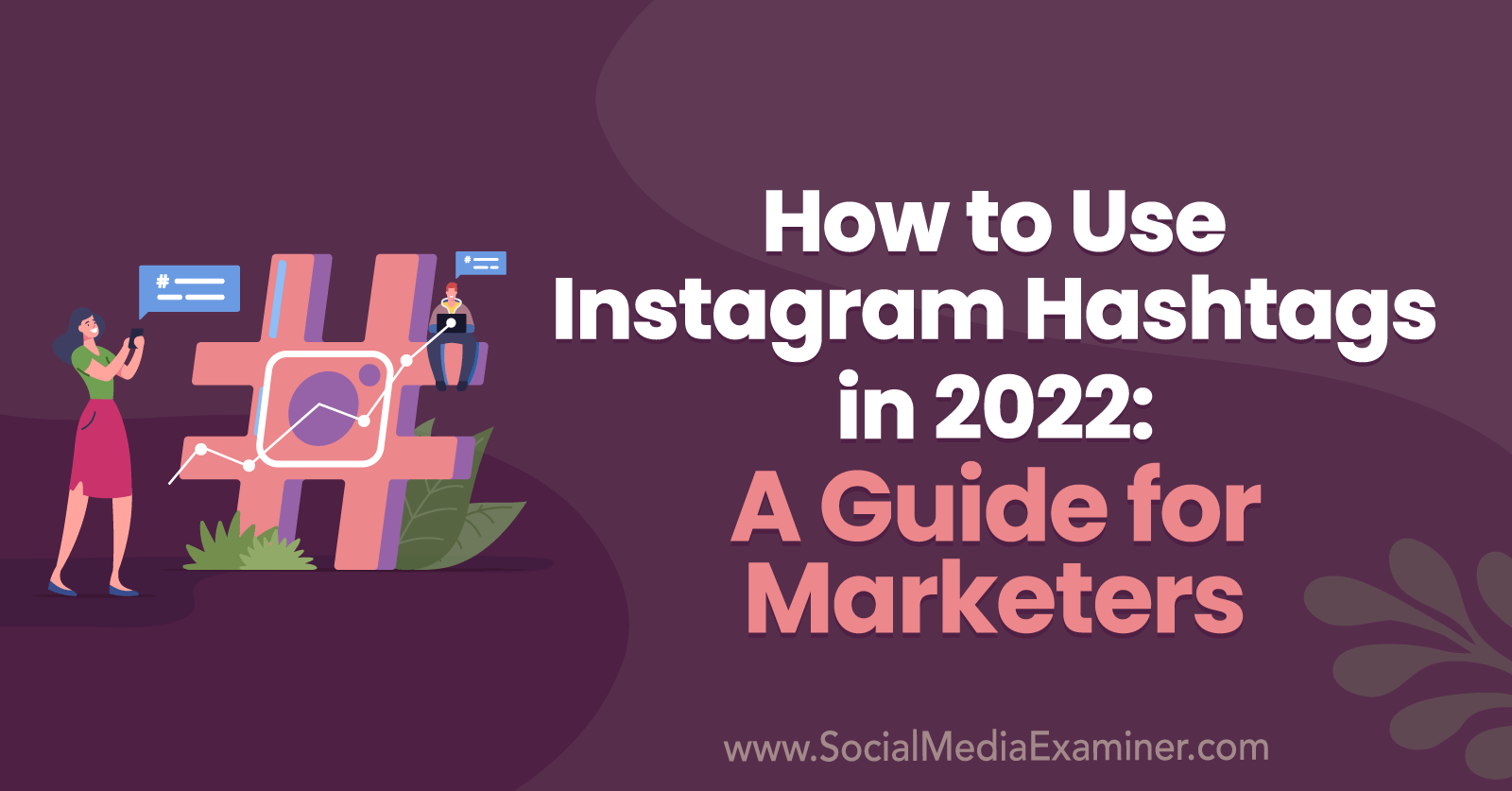
4 Reasons for Marketers to Use Hashtags on Instagram
Let’s begin with the basics. A hashtag is a word or phrase preceded by the “#” symbol. On social media networks like Instagram, hashtags are hyperlinked. When users click or tap them, Instagram opens the related hashtag page.
But if you’re not exactly new to Instagram marketing, then you know there’s much more to hashtags than the linked pages. Hashtags can help with everything from discovery to promotion, and they can have both immediate and long-term benefits. Here’s a little more insight into how hashtags work and why you should use them.
Improve Discovery
When you search for a hashtag on Instagram, you’ll see a page that looks a lot like the #instagrammarketingtips example below. On the mobile app, hashtag pages feature a selection of top posts that have a ton of engagement. Next to that, there’s a Recent tab that shows content in chronological order and a Reels tab with relevant short-form videos.
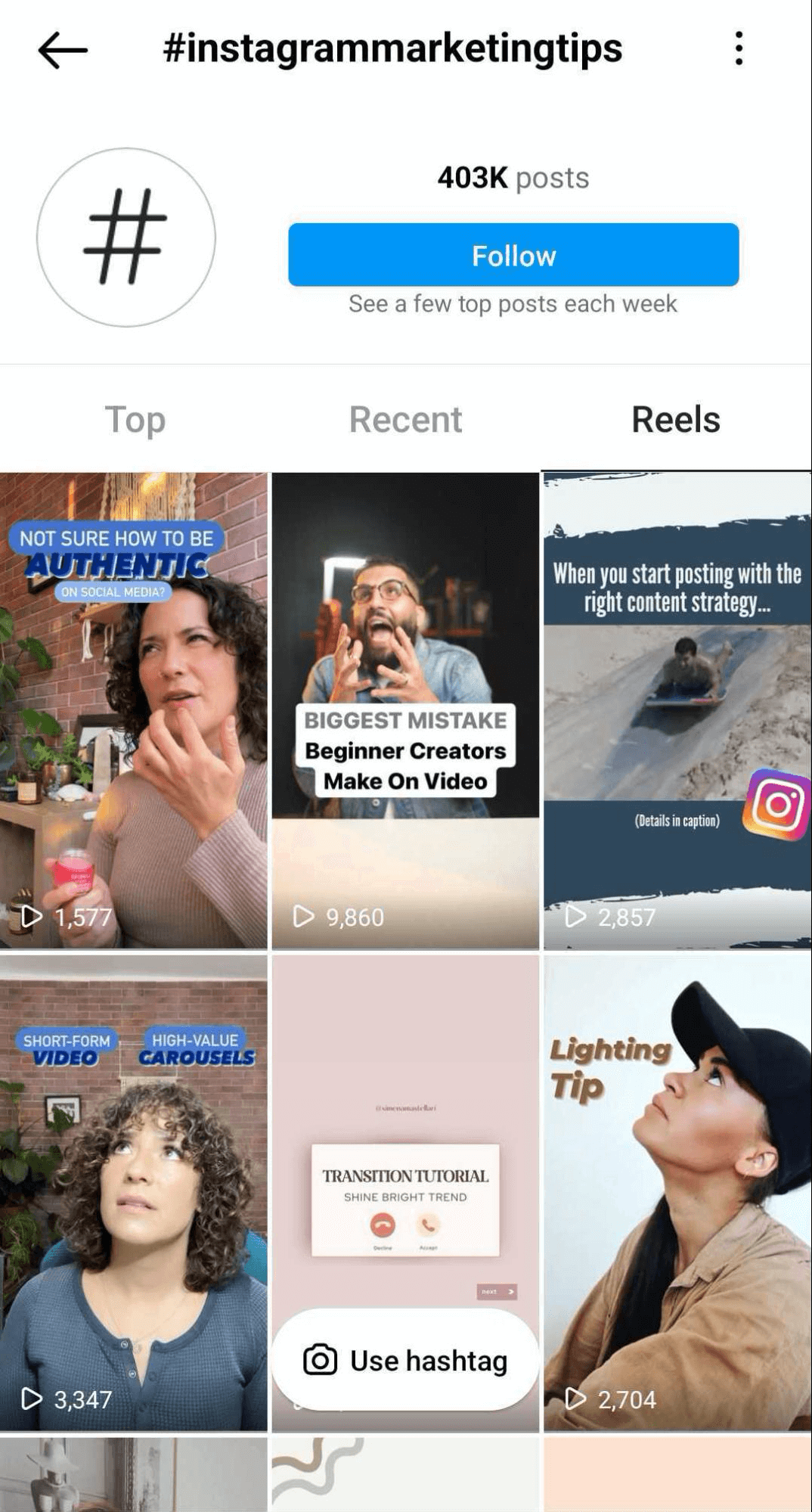
If you include hashtags in your Instagram content, it appears on relevant hashtag pages. In other words, when users search for the hashtags you use, they can easily discover your brand and your content.
Increase Reach
As you can see in the #instagrammarketingtips example above, hashtag pages include Follow buttons. Users who click or tap to follow a hashtag automatically see content featuring that keyword or phrase in their feeds.
If you use hashtags that a lot of people follow, you increase the chance of your brand’s content appearing in users’ feeds, even if they don’t follow your brand yet. That means hashtags can be great for both reach and discovery.
Add Context
No matter what type of Instagram content you create, there’s really no shortage of space to convey your message. Feed posts have 2,200-character caption limits, while Stories and Reels allow ample opportunities for text overlays and voiceovers.
Yet even with all those options, it can still be challenging to specify exactly what your content is about. With hashtags, you can provide added context that helps clarify the topic for users and tell the algorithm when it’s appropriate to deliver your content to feeds.
For example, the @onmollysplate Instagram story below includes an interactive hashtag in the text. Users can tap it to see more related content or follow the hashtag.
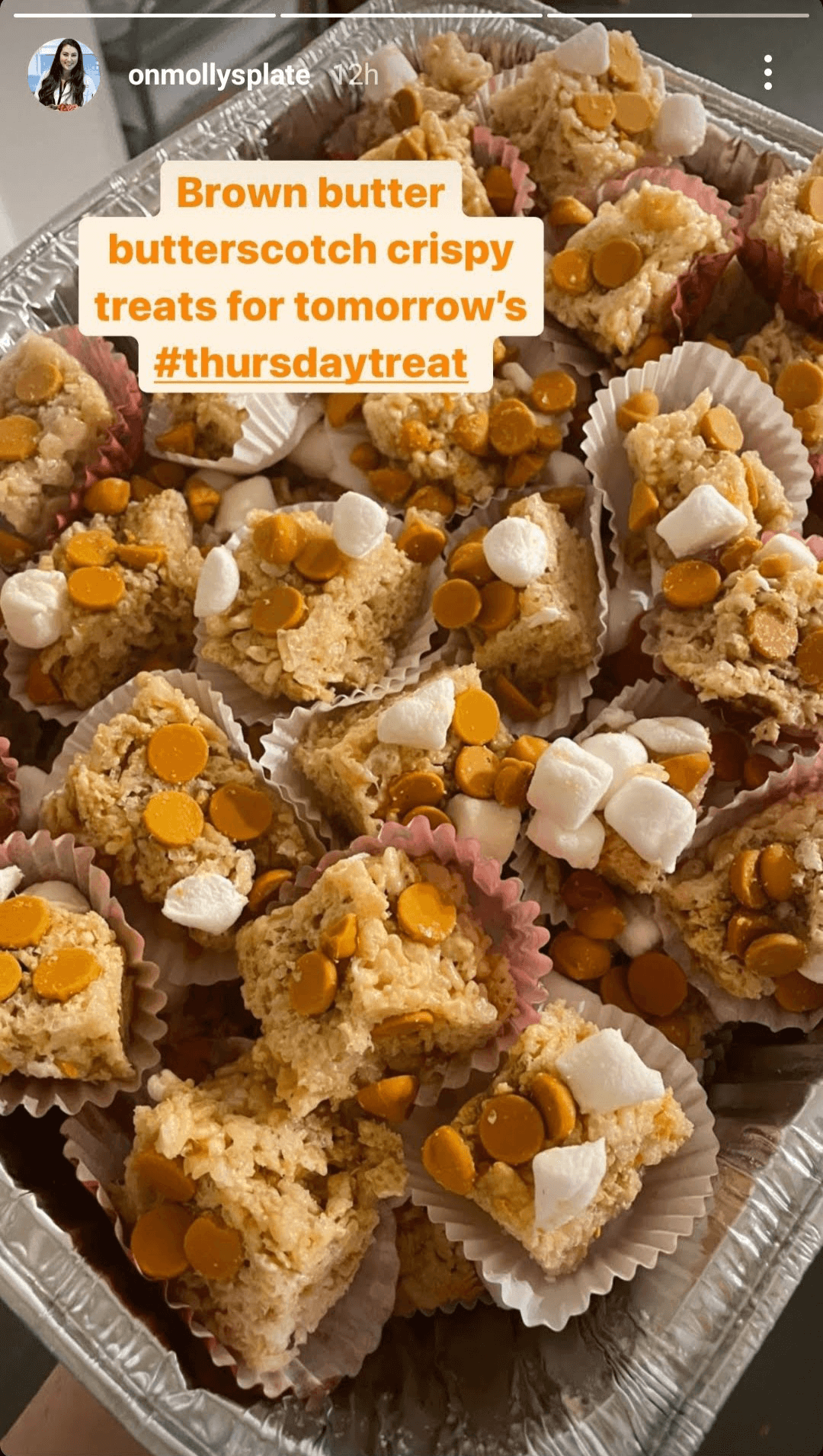
Promote Campaigns
In addition to providing context, hashtags are ideal for promoting campaigns. With a unique campaign hashtag, you can draw attention to your brand’s initiative or event and keep track of all of the content created around it.
If you’re running a contest or collecting user-generated content (UGC), campaign hashtags are essential. By adding your brand’s hashtag to their content, users can enter your contest or submit their UGC without worrying about their post getting lost in the shuffle.
For example, the @canva Instagram story below features a campaign hashtag. Users can enter the design app’s challenge by adding this hashtag to their content or they can search the hashtag to browse entries. The brand can monitor the hashtag to collect entries and determine a winner.
Get World-Class Marketing Training — All Year Long!
Are you facing doubt, uncertainty, or overwhelm? The Social Media Marketing Society can help.
Each month, you’ll receive training from trusted marketing experts, covering everything from AI to organic social marketing. When you join, you’ll also get immediate access to:
- A library of 100+ marketing trainings
- A community of like-minded marketers
- Monthly online community meetups
- Relevant news and trends updates

#1: How to Choose Your Instagram Hashtag Mix
Hashtags can provide a wide range of information about your content. Here are 10 types of Instagram hashtags to consider:
- Branded hashtags that are specific to your business
- Campaign hashtags that are unique to a marketing initiative
- UGC hashtags that are designed for customers to use
- Event hashtags that promote happenings and holidays
- Location hashtags that indicate where something is happening—for local customers
- Daily hashtags that reflect themes like #MondayMotivation
- Industry hashtags that explain your field or type of work
- Community hashtags that share information and amplify voices
- Descriptive hashtags that clarify the topic of the content
- Phrase hashtags that include a message or an inspirational statement
The total number of hashtags you can use on Instagram depends on the content type. Feed posts and reels support 30 hashtags, while stories can include 10 hashtags. Although it’s easy to assume that you should add as many as possible, that’s not necessarily best practice.
Many experienced marketers recommend maxing out hashtags or using a certain number of keywords from various categories. However, Instagram recommends keeping hashtags to a minimum. A recent feed post by the official Instagram @creators account specifically recommends using three to five hashtags instead of adding 10 or 20.
So which suggestion should your team follow? It’s probably best to use the official advice from Instagram and keep hashtag usage to a minimum. But you shouldn’t hesitate to experiment. Test different numbers of hashtags and compare reach and engagement metrics to see what works best for your brand.
How to Find the Best Hashtags for Instagram
Whether you plan to use the recommended number of hashtags or experiment with more, it’s important to make them count. Let’s look at some tools and tactics that can help you find the best hashtags for your content.
Instagram Hashtag Search
The Instagram app offers the simplest way to find hashtags, as long as you know what you’re looking for. Type any keyword or phrase into the app to see how many times any hashtag has been used. If the hashtag you’re considering has only been used a few times, it’s probably best to replace it with one that has more traffic.
In addition to the keyword you searched for, Instagram also provides data for several similar hashtags. You can use these ideas as replacements or additions to your hashtag list.
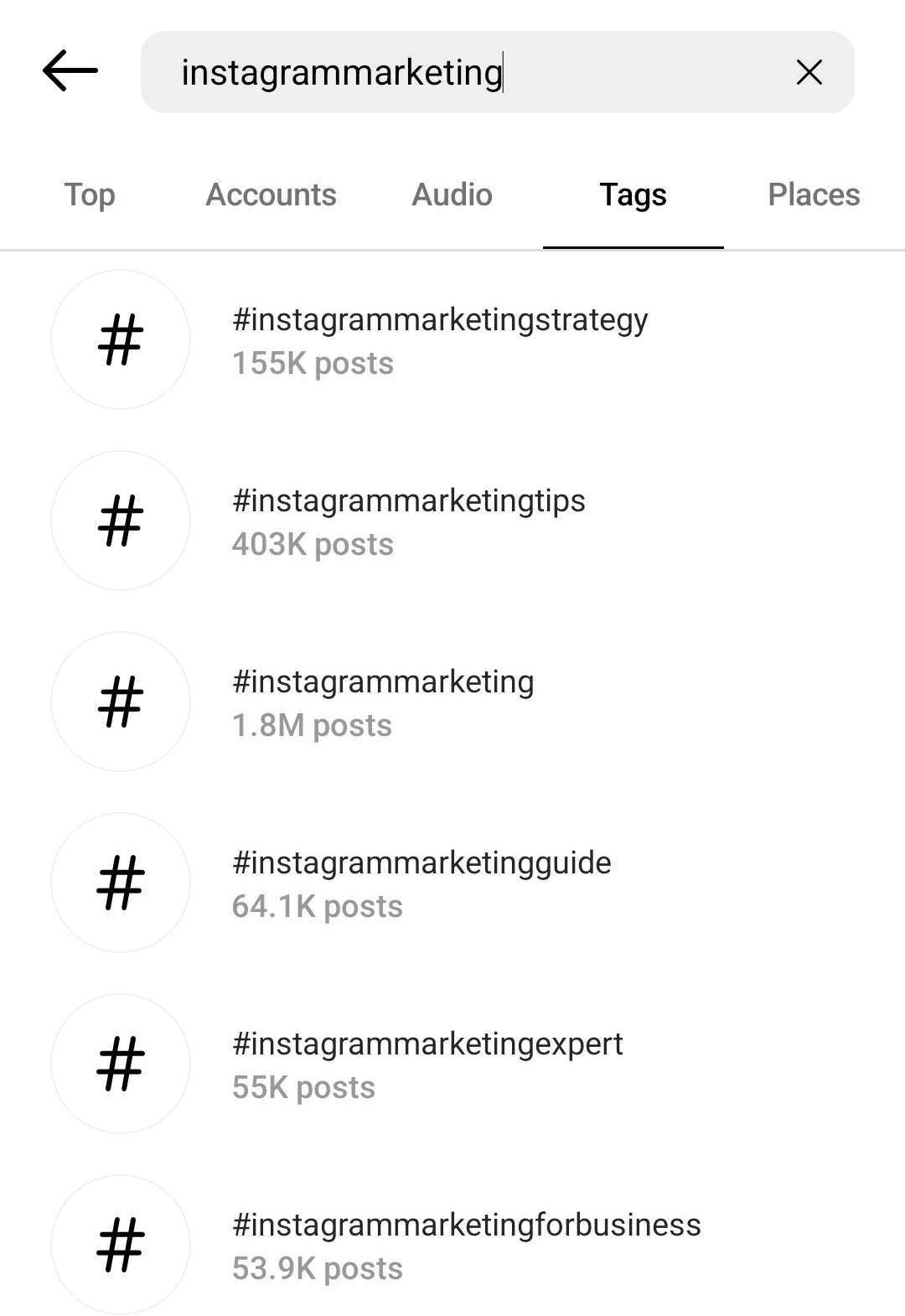
Follower Research
If you’re not sure where to start with your research or if you’re looking for new ideas, you can turn to other Instagram accounts. Think influencers, competitors, or industry leaders. Tap to open their profile, and then tap Following.
At the top of the list, you’ll see a list of hashtags the account follows. You can tap to see the full list and then tap to follow any hashtag or see relevant content. If you find any that appear to have potential, you can add them to your list.
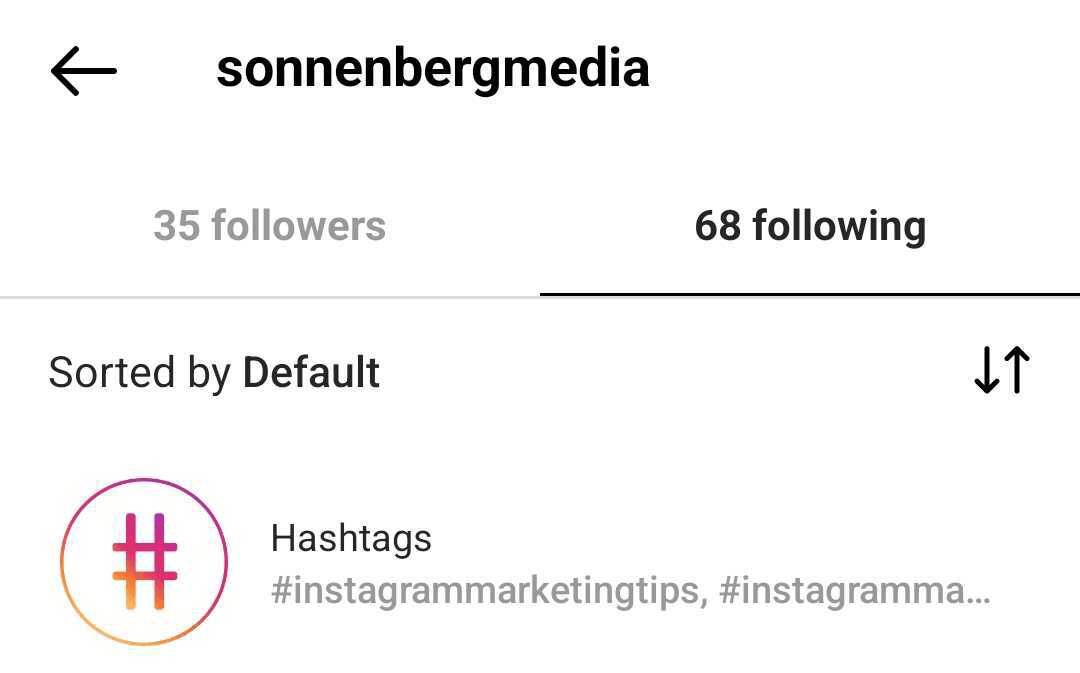
Hashtag Research Tools
As helpful as these native tools are, they don’t help you identify what’s popular right now. To find trending hashtags, you need a third-party tool like RiteTag. With RiteTag, you can upload the caption and media for your Instagram post and allow the app to autogenerate hashtag ideas.
The app color-codes suggestions so you can separate the trending hashtags from the evergreen options. It also highlights overused hashtags to avoid. You can copy and paste hashtag lists from RiteTag into your scheduling tool to add them to an Instagram post instantly.
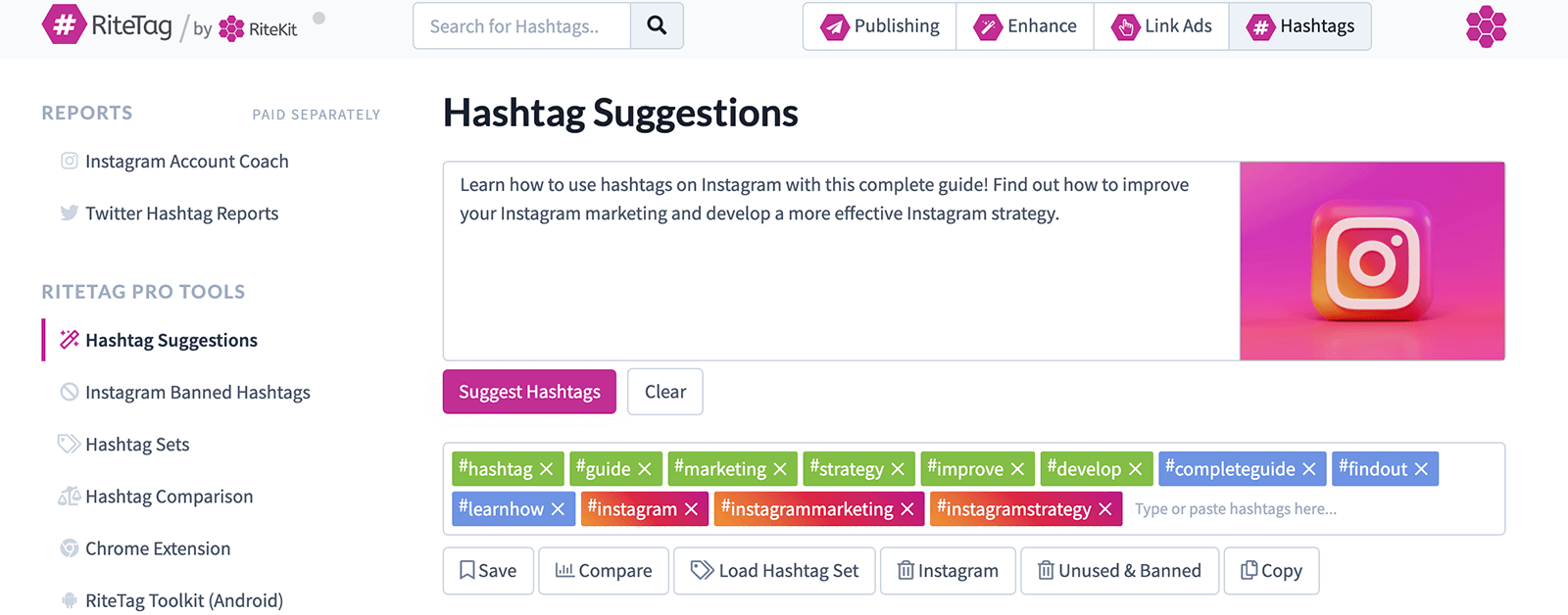
#2: How to Place Hashtags in Your Instagram Content
Every type of Instagram content supports hashtags. Here’s where they tend to be the most effective.

Discover Proven Marketing Strategies and Tips
Want to go even deeper with your marketing? Check out the Social Media Marketing Podcast! Publishing weekly since 2012, the Social Media Marketing Podcast helps you navigate the constantly changing marketing jungle, with expert interviews from marketing pros.
But don’t let the name fool you. This show is about a lot more than just social media marketing. With over 600 episodes and millions of downloads each year, this show has been a trusted source for marketers for well over a decade.
Instagram Feed Posts
Both image and video feed posts support hashtags anywhere they can be hyperlinked. In other words, don’t include them in the image or video itself but do add them to the caption. Although you can certainly incorporate hashtags into the caption text, this practice doesn’t always lend itself to the most pleasant reading experience for your audience.
That’s why it’s typically best to list them at the end of the caption, usually on a line that’s separate from the rest of the text. To create visual space and make the caption easier to read, you can add a line break or use symbols or emojis to separate the hashtags.
For example, the @hellobonjournal Instagram post below includes several hashtags at the end of the post, separated from the text by line breaks. The hashtags cover the creator’s industry and location and use both phrases and keywords to increase reach and drive discovery.

What about placing hashtags in feed post comments? While some marketers opt to keep captions clean and add hashtags to comments, Instagram recommends against this practice. In fact, a recent @creators Instagram post instructs users to put hashtags in captions.
Instagram Reels
Because Instagram reels function a lot like feed posts, you can follow the same recommendations for adding hashtags to short-form videos. That means avoiding adding hashtags to text overlays and including them in the caption instead.
For example, the @mirohq Instagram reel below includes a handful of hashtags in the caption. From branded hashtags to descriptive keywords, they provide context and ensure that the content displays on relevant search pages.
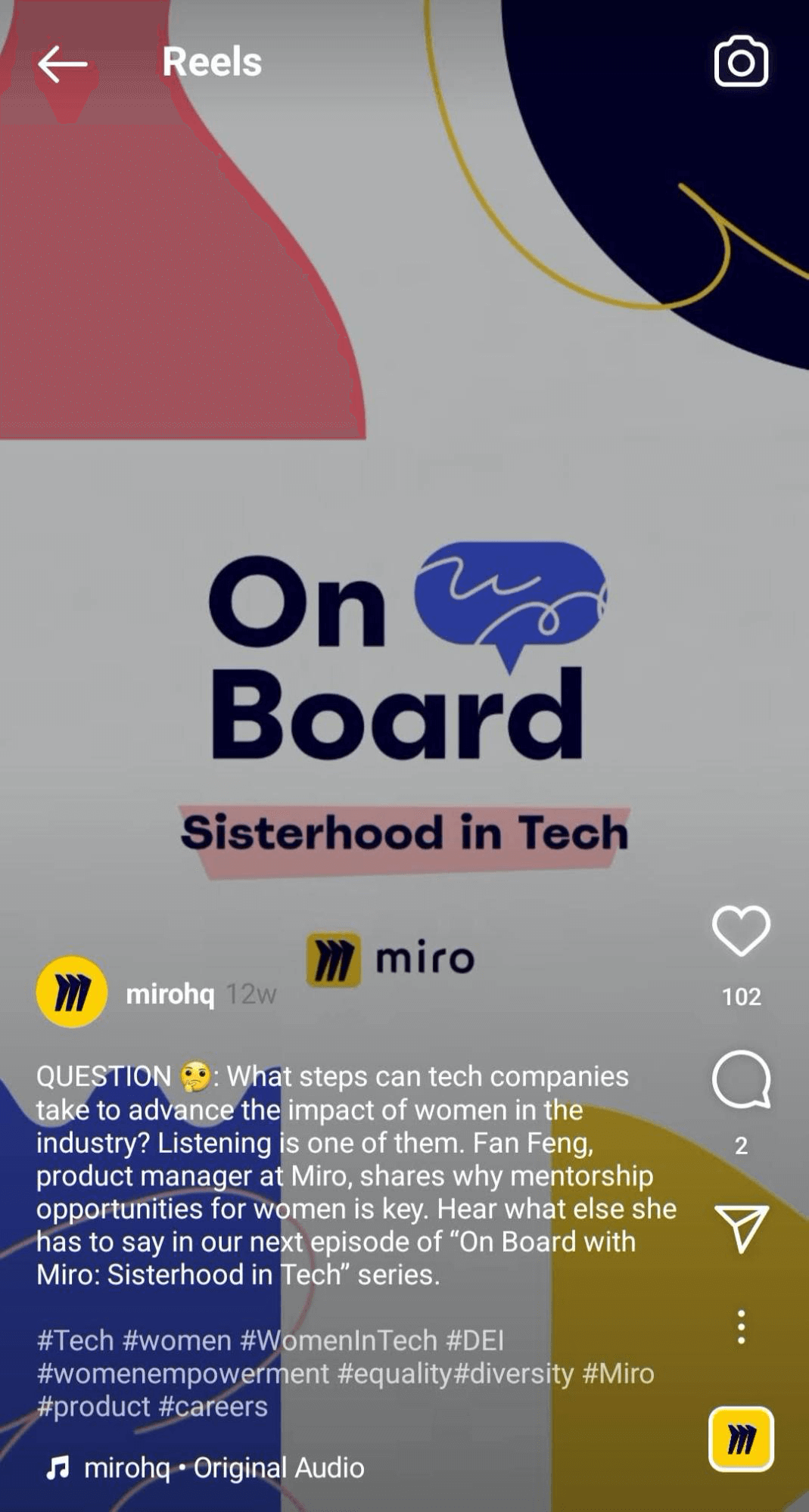
Instagram Stories
Instagram Stories offers two options for adding hashtags. If you include hashtags in a text overlay, they automatically become tappable. If you use a hashtag sticker, they work exactly the same way. People who tap them see a Visit Hashtag pop-up that leads to the hashtag page.
So which results in more engagement? Neither necessarily works better than the other, making story hashtags more of an aesthetic decision. Including them in the text usually is a smoother reading experience, while calling them out with a sticker can draw more attention.
No matter which you choose, keep in mind that hashtag pages don’t usually display stories. So adding hashtags to stories is less about driving discovery and more about directing followers to a campaign.
For example, the @flourcraft Instagram story below features a daily hashtag in a simple text overlay. Users can tap the hashtag to see more content or tap the featured content to see the original feed post.
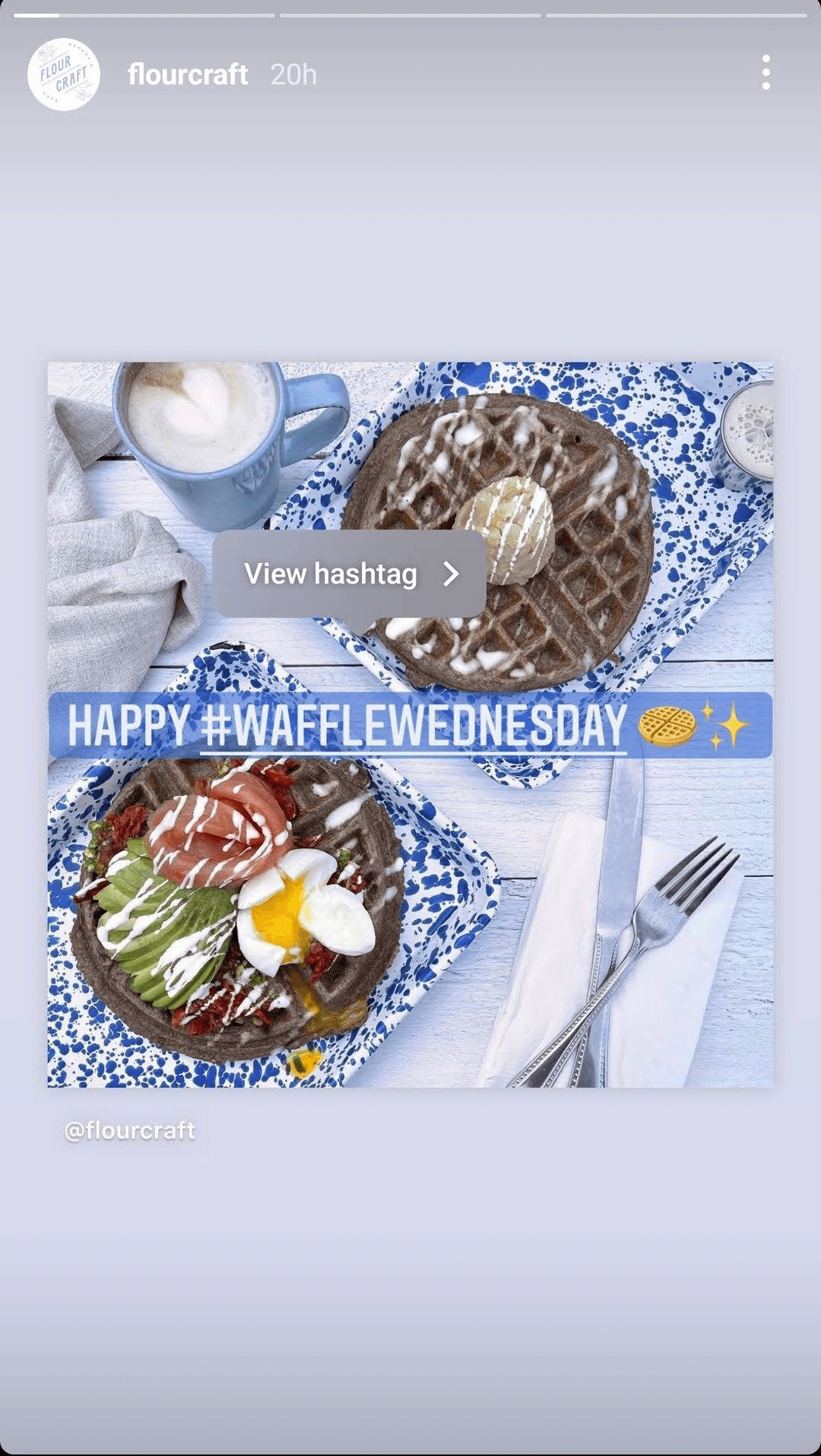
Instagram Bio
You can also add hashtags to your brand’s Instagram bio but it’s important to note that they work a little differently on your profile versus in content. Adding hashtags to your Instagram bio won’t increase the chance of your profile appearing in search, nor will it increase your reach.
But you might want to add a hashtag to your bio if your team uses Instagram to collect UGC or run branded campaigns. That way, people can tap the hashtag in your bio to see all of your customer posts and even contribute some of their own.
#3: How to Track Instagram Hashtag Performance
To develop an effective Instagram hashtag strategy, it’s important to know which ones are helping you reach your goals and which are just taking up space. Let’s look at both native and third-party tools.
Instagram Insights
Both Instagram Insights and Creator Studio Insights can tell you how much reach your hashtags generated. But both tools tally hashtag reach per post. If you add multiple hashtags to every post, you can’t see how much each one contributed.
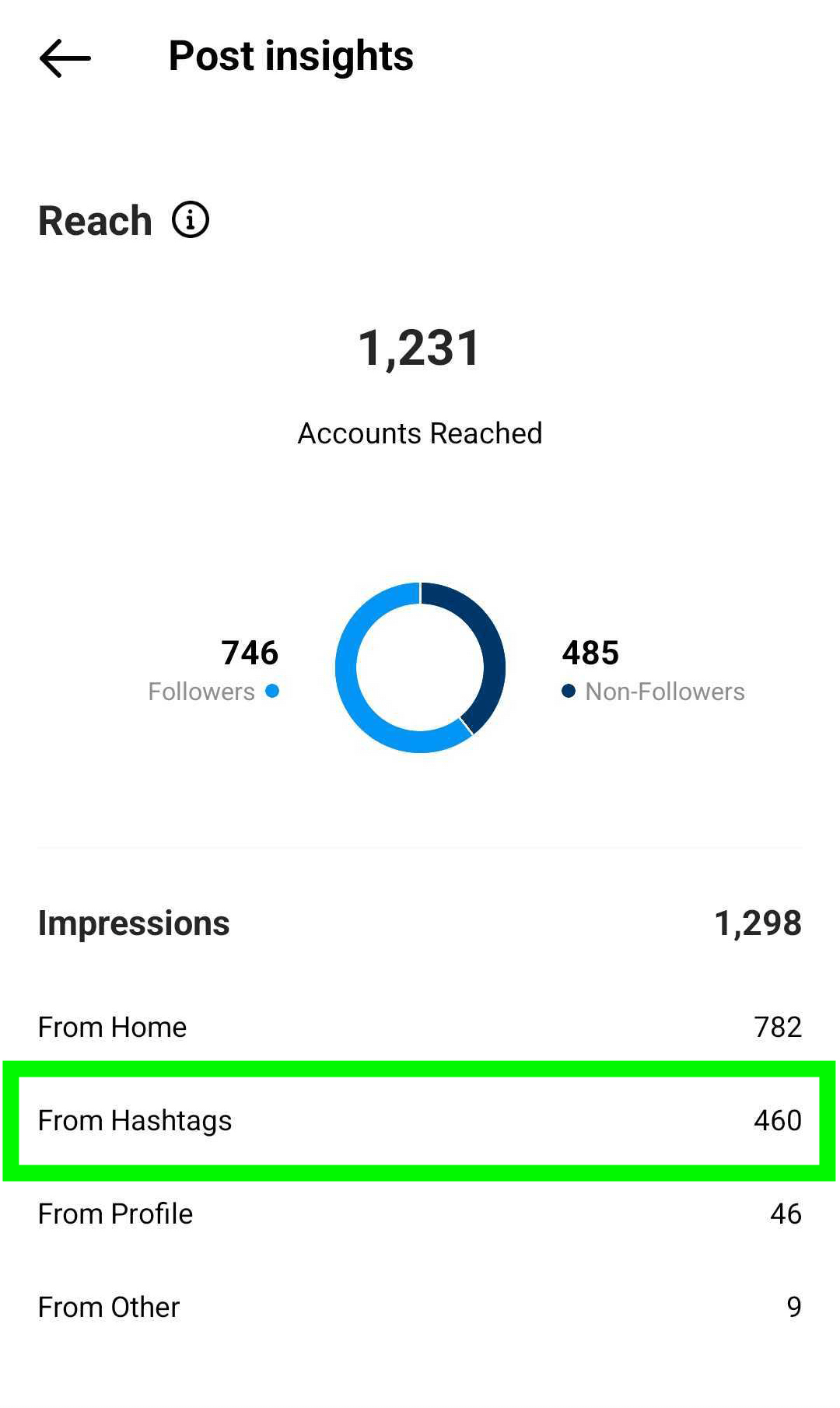
Third-Party Analytics
For more granular detail, a third-party hashtag monitoring tool or social media scheduling dashboard is necessary. These tools connect directly to your Instagram account so they can monitor activity on your posts and tally interactions for every hashtag.
They also provide more detailed insights that give you a significantly more in-depth understanding of hashtag performance. For example, most track engagement rates for hashtags so you can easily identify which offer the greatest value.
#4: How to Improve Your Instagram Hashtag Strategy
As you develop your Instagram hashtag strategy, keep these best practices in mind.
Mix Up Your Hashtag Rotation
Researching hashtags takes time so it’s tempting to reuse or even copy and paste the same ones again and again. However, Instagram Community Guidelines prohibit posting repetitive captions or comments, which includes hashtag lists.
Although the platform probably won’t ban accounts for using repetitive hashtag lists, it may decrease your organic reach. If you want to get maximum value from your hashtags, it’s important to vary your regular rotation.
For example, @_thepeachfuzz Instagram post below uses a variety of hashtags tailored to the content. The creator uses a different mix of hashtags for virtually every post, effectively maximizing reach and discovery.
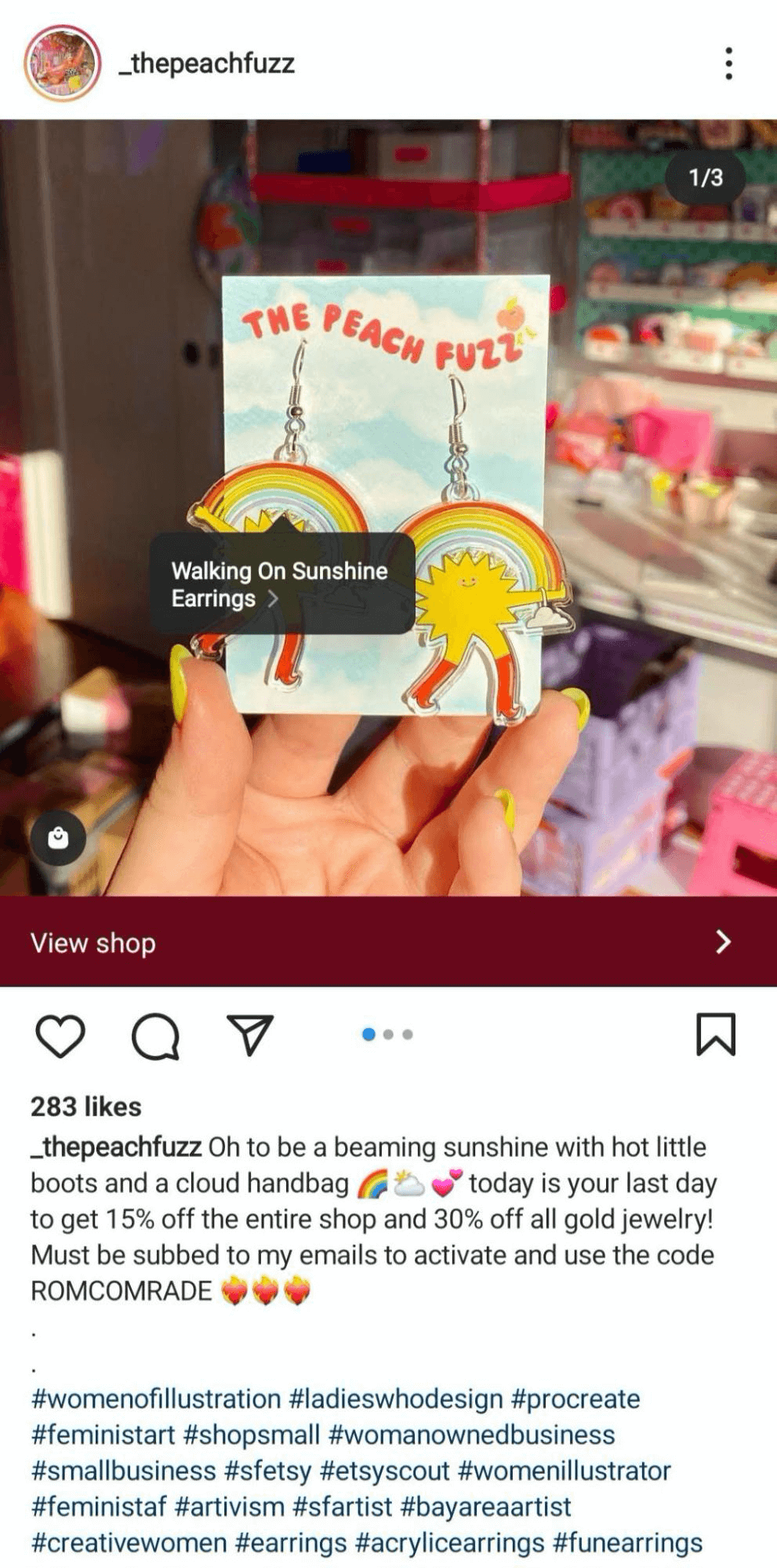
Avoid Banned or Overused Hashtags
Ideally, the hashtags you choose will increase your reach rather than compromise it. However, Instagram does moderate delivery of content that includes hashtags the platform considers spammy.
If you use research tools like RiteTag, you can easily spot banned hashtags and remove them from your list. But you can also search Instagram directly. If the platform won’t allow you to search for a specific hashtag, that means it’s banned and you should absolutely avoid it.
Balance Trending and Unique Hashtags
You already know to avoid hashtags with minimal traffic. But what about hashtags that are incredibly popular or even viral? Although viral hashtags could theoretically increase your reach, they get so much traffic that your content would instantly get lost on the hashtag page.
Instead, look for hashtags that are popular but not overly trendy. For example, prioritize hashtags with 100,000 rather than 1 million Instagram posts to strike the ideal balance. Start by entering a common hashtag into Instagram search, and then scroll down to see recommendations with the right level of popularity.
Conclusion
Whether you want to increase reach, drive discovery, or promote a campaign, hashtags are key, especially if you know which to use and when to add them. With this guide, you can get more mileage out of your Instagram hashtags so you can apply them more effectively and reach more marketing goals successfully.
Get More Advice on Instagram Marketing
- Build an Instagram sales funnel that works.
- Maximize your Instagram video strategy in 2022.
- Set up an Instagram shop.
Stay Up-to-Date: Get New Marketing Articles Delivered to You!
Don't miss out on upcoming social media marketing insights and strategies! Sign up to receive notifications when we publish new articles on Social Media Examiner. Our expertly crafted content will help you stay ahead of the curve and drive results for your business. Click the link below to sign up now and receive our annual report!
Attention Agency Owners, Brand Marketers, and Consultants

Introducing the Marketing Agency Show–our newest podcast designed to explore the struggles of agency marketers.
Join show host and agency owner, Brooke Sellas, as she interviews agency marketers and digs deep into their biggest challenges. Explore topics like navigating rough economic times, leveraging AI, service diversification, client acquisition, and much more.
Just pull up your favorite podcast app, search for Marketing Agency Show and start listening. Or click the button below for more information.

